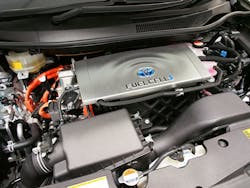Content brought to you by Auto Body Repair Network. To subscribe, click here.
What you'll learn:
- What is a FCEV?
- Why some industry analysts believe FCEVs will be the preferred long-term choice over BEVs
- PPE and safety guidelines needed for working on FCEVs
Well… probably not at present. Unless you work at one of the few OEM dealerships that support hydrogen fuel cell vehicles (FCEVs), the odds of encountering a hydrogen vehicle are low. They are almost exclusively available for sale in a few select states and are unavailable for purchase to most of us.
However, the first commercially produced fuel cell vehicles were released in 2013, and many of these early vehicles made by Honda, Hyundai, and Toyota have found their way into the secondary market. I know a few folks here on the East Coast who own previously owned FCEVs, so there are a few around, and there are also some internal combustion engine conversions out there that use hydrogen as a fuel source. Even though hydrogen vehicles are currently few and far between, many in the automotive field predict the future of transportation will reside in hydrogen fuel cell vehicles. A quick tutorial on how they operate, along with proper safety procedures, is a good primer for those who will see them in the near or distant future. After all, Jay Leno and James May, both automotive personalities I highly respect, have stated that FCEVs are where we need to go.
The implementation of hydrogen vehicles is progressing much slower than projected ten years ago and is seemingly being pushed aside by the aggressive growth of electric cars. Nevertheless, as mentioned previously, many industry analysts still say that hydrogen fuel cell vehicles are our future, will be a preferred long-term choice over electric cars, and that we should be prepared to support the technology once it becomes more mainstream. I'd have to agree with them. With growing concerns about the climate and the effects of fossil fuel-driven transportation, FCEVs check a lot of boxes that need to be addressed:
- They run solely on the most widely available element on the earth, hydrogen
- They are an actual "zero-emission" vehicle, with only water vapor emitting from the tailpipe
- Millions of dollars in private and public money are being invested in their development
- There are multiple state and federal incentives available to buyers that can take a big chunk out of a new FCEV purchase price
So, on the surface, hydrogen cars appear to be an excellent option for many reasons. However, their implementation has been hampered by the cost of the fuel cell, the unavailability of hydrogen fueling stations, and the struggles to produce hydrogen environmentally, simultaneously reducing the cost.
What exactly is a hydrogen vehicle?
Since the emergence of hydrogen cars, two system configurations have been researched that utilize hydrogen as their fuel source: hydrogen-powered internal combustion engines (ICE) and hydrogen fuel cell electric vehicles (FCEVs). A hydrogen-powered ICE vehicle is very similar to conventional cars in that it has an ICE that burns hydrogen as its fuel, similar to today's propane and CNG vehicles. Their drivetrain is identical to a conventionally powered ICE, with the gasoline tank and fuel delivery system replaced with a high-pressure hydrogen fuel cylinder, fuel lines, and a system of regulators to reduce the fuel pressure before it enters the combustion cylinders. On the other hand, an FCEV is an advanced technology vehicle that uses a fuel cell to generate electricity and uses hydrogen fuel to produce the electrical power that propels the vehicle. FCEVs are zero-emission vehicles similar to electric cars. However, FCEVs produce electricity on board from hydrogen to drive the vehicle's electric motor rather than from a battery that has been charged from an EV charging station. The onboard production of an FCEV's electricity occurs in a device that is the heart of an FCEV, a fuel cell.
FCEVs also contain a lithium battery similar to electric vehicles used to store excess electricity generated by the fuel cell and any power generated by the vehicle's regenerative braking system.
Hydrogen safety
Although hydrogen is not a poisonous gas, it can displace oxygen in a confined area. However, it tends to diffuse rapidly. As it is lighter than air, it rises when released. Rising hydrogen gas can create a safety issue if it becomes trapped. Repair facilities and fueling stations that service hydrogen vehicles are typically designed with ample ventilation so that hydrogen gas will not collect underneath the building's roof and can disperse in the event of a leak. Hydrogen sensors may also be installed in such facilities and be connected to an alarm system that is both audible and visual.
Hydrogen is flammable and burns with a pale blue flame that is difficult to see in daylight. The flame is smokeless and does not radiate very much heat. Therefore, it may be difficult at first to identify a hydrogen flame. An infrared camera can be used to view the heat signature of a hydrogen flame. A common straw broom can also be extended into the location of the suspected fire to see if it ignites.
As with most other gaseous-fueled vehicles, a hydrogen fuel cell vehicle will have at least one temperature relief device (TRD) mounted on the vehicle's hydrogen storage tank. Many hydrogen fuel cell vehicles have multiple hydrogen storage tanks. If so, each tank will have at least one temperature relief device. These devices are designed to rapidly vent hydrogen gas if the temperature at the device exceeds a given temperature (approximately 230 degrees F or 110 degrees C).
So… what does a collision specialist need to know?
In this day of alternative fuels and fueling systems, a collision repair shop should recognize the type of vehicle they are repairing. Relying on the consumer or the referral shop to correctly define the type of vehicle you will be servicing is no longer an option. Recognizing a hydrogen vehicle for what it is IMMEDIATELY upon its arrival at your facility is the first step in its practical and safe repair. Industry-standard labels can often identify gaseous fuel vehicles but should not be relied upon as the sole method of vehicle identification. Looking at the vehicle's fueling ports, checking for non-standard gauges on the dashboard, and examining the type of fuel tanks located in the vehicle are other ways of recognizing the type of fueling system on a vehicle.
Once a vehicle has been recognized as a hydrogen vehicle, it is good practice for all shops to label it as such. Using a grease pencil to write "Hydrogen" on the front and rear glass, placing a bright red hangtag on the wiper arm, or simply taping a piece of paper to the hood clearly labeling a gaseous fuel vehicle as it enters your shop is a best practice everyone should follow. This label will inform everyone, from the service writer to the detail crew, that a non-standard fuel system is present in the vehicle, laying the groundwork for a safe vehicle repair pathway.
Most of an FCEV's components and systems parallel those of an electric vehicle. For example, the high-voltage battery, electric motor, control systems, and inverters use the same technology as EVs, and a diagnostic and repair technician familiar with electric vehicles will feel at home with the vehicle with two exceptions. The differences between EVs and FCEVs reside in the fuel storage system and the fuel cell.
As for safety, the technician should follow many of the same guidelines they follow for EVs and CNG vehicles:
Use of HV-insulating gloves and over-protectors
Removal of HV battery pack service plugs before component service
Use of HV-rated meters and leads
Understanding the proper defueling methods when removing compressed hydrogen from a vehicle's fuel tank
The hydrogen fuel storage and delivery system will be very familiar to those familiar with CNG vehicles. Hydrogen is stored in the vehicle in a fiber-wrapped fuel cylinder at pressures up to 10,000 psi and is filled at fueling stations similar to CNG technologies. An FCEV can be filled with hydrogen in about the same amount of time it takes to fill a gasoline and diesel vehicle, a distinct advantage over EV charging.
The fuel cell, however, will be maintained and repaired by specialized OE personnel for the foreseeable future. Fuel cells are complex, have no user or local technician parts that can be replaced, and are very well-protected pieces of technology whose operation and construction are guarded secrets. They are also the most expensive component in the vehicle and can make up over half the price of the whole vehicle. Therefore, it will be a very long time before our industry is capable of any fuel cell repair at the local level.
The vehicle's repair and safety information is a great place to acquire information on a hydrogen fuel vehicle. Automotive upfitters and manufacturers offer a vast knowledge of all vehicles, including their gaseous fuel products. In addition, many third-party organizations provide training, which can be accessed online.
Collision Repair Guidelines
It is hopefully a given that this article should not be used as a replacement for quality training. Instead, it is designed to give the collision repair technician an overview of the unique structure and associated techniques needed to repair hydrogen vehicles and provide them with a launch pad to pursue quality training for proper collision repair.
The vehicle's hydrogen fuel cylinder must be defueled of all fuel and the tank purged of any residual gas before repair work can begin. An alternative to defueling the tank would be to remove the tank entirely from the vehicle. Once the fuel has been removed from the tank or the tank taken from the vehicle, the collision repair process can proceed, including conventional paint curing. The defueling process or safe removal of the fuel cylinder requires specific tools, systems, and training defined by codes and standards, including environmental guidelines. Therefore, fuel handling is the prime topic that a collision repair specialist should seek training on. Unlike liquid vehicle fuels, a gaseous fuel leak can be extremely dangerous to those working around it and the building where the vehicle is being repaired. Understanding the vehicle and the fuel is why quality training is required before addressing the repair of hydrogen-fueled vehicles.
Before preparing a facility and its staff for hydrogen fuel vehicle repair, a collision shop should also research local building codes and standards to determine structural repair facility requirements for gaseous fuel storage, ventilation, electrical systems, and other local or national guidelines.
About the Author
Micheal Smyth
Micheal Smyth is a founding partner and Director of Training for AFV Educate, a not-for-profit 401(c)(3) training organization specializing in alternative fuel curriculum development and educational presentation for first and second responders and automotive technicians. His previous positions included Director of West Virginia University’s National Alternative Fuels Training Consortium and Director of Training at Automotive Video Innovations. Mike has over 12 years of experience working with and presenting information on AFVs. Connect with him at LinkedIn.

